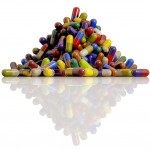
There continues to be a considerable amount of debate about the amount of psychiatric medication that is prescribed and how much it costs. Statistics from a number of countries have shown that many classes of drugs are being prescribed more and more, including antidepressants, antipsychotics and stimulants.
Of course, as populations grow, people live longer and drug technologies improve, you would expect prescriptions to increase year on year. The question on many peoples’ lips is whether we are ‘medicalising’ conditions and treating people with drugs when other approaches might be more beneficial.
The costs of newer drugs are also a major issue with wider usage of the more expensive antipsychotics causing mental health to take a bigger slice of the budget than it has done in previous years.
Added to this is the increasing trend for ‘off label’ prescriptions, where psychiatric drugs are given to patients for conditions for which they don’t have regulatory approval. For example, research is emerging in the US which shows that antidepressants are frequently given to patients who have not been diagnosed with a mental health problem (Olfson et al).
This new study published in the British Journal of Psychiatry examines trends in prescribing of all the major classes of drugs prescribed for mental disorders in England between 1998 and 2010, based on data on community-issued prescriptions collected in the annual Prescription Cost Analysis survey. The authors have conducted a regression analysis to compare trends for the different classes of drugs.
Some drugs (e.g. lamotrigine and carbamazepine) were not included in the analysis because, although they are increasingly used to treat mental health conditions, they are predominantly used to treat other non-mental health conditions.
Here’s what they found:
- From 1998-2010, drug prescriptions for mental disorders increased 6.8% (95% CI 6.3–7.4) per year on average
- Costs of other prescription drugs rose by 2.6% (95% CI 0.96–4.3) per year on average
- Drug prescriptions for mental disorders therefore made up an increasing proportion of all prescription drug costs (P=0.001)
- Antidepressant prescriptions increased by 10% (95% CI 9.0– 11) per year on average
- Antipsychotic prescriptions increased by 5.1% (95% CI 4.3–5.9) per year on average
- Prescriptions of hypnotics and anxiolytics increased slightly, but not to a statistically significant degree
- The cost of psychiatric medication rose by 4.9% (95% CI 2.3– 7.5) per year on average
- The cost of other prescription drugs rose by 2.6% (95% CI 0.96–4.3) per year on average
- The cost of antipsychotic drugs rose by 22% (95% CI 16.7–27.4) per year on average
The authors concluded:
Rising prescriptions may be partly explained by longer-term treatment and increasing population. Nevertheless, it appears that psychiatric drugs make an increasing contribution to total prescription drug costs, with antipsychotics becoming the most costly. Low-dose prescribing of some antipsychotics is consistent with other evidence that their use may not be restricted to those with severe mental illness.
Links
Ilyas S, Moncrieff J. Trends in prescriptions and costs of drugs for mental disorders in England, 1998–2010 Br-J-Psych bjp.bp.111.104257; published ahead of print March 22, 2012, doi:10.1192/bjp.bp.111.104257 [Abstract]
Olfson M, Marcus SC. National patterns in antidepressant medication treatment (PDF). Arch Gen Psychiatry 2009; 66: 848–56.
